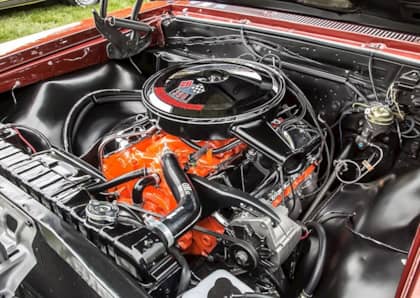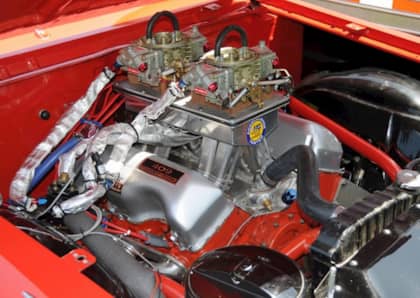The Big Block C2 And C3 Corvettes Ruled Chevy's High Performance Muscle Car Golden Age
The Chevrolet Corvette is an American icon but it wasn't always the hot performer that it is today. It took two generations of Corvette before the sports car gained the kind of power required to truly turn heads in Detroit, and towards the end of its first decade it took a muscular leap forward with the introduction of a big block V8.

The Corvette's big block period lasted a scant 10 years before being choked out by a grim economy and even darker emissions restrictions from the EPA. During that time, however, the massive cubic inches under its hood allowed the exotic-looking Vette to dominate the automotive scene in a way it would never quite repeat, providing classic Corvette fans with a golden age of outstanding performance and tire-melting torque.
NASCAR Mysteries
Chevrolet had long used the Corvette as a test bed for the latest and greatest drivetrain technologies, including the Rochester fuel injection system that had been introduced with the 1957 C1 generation car. With 'fuelie' engines still on offer by the time the C2 Sting Ray debuted in 1963, General Motors began seeking the next phase in the Corvette's evolution, but there was no simple solution. The 'Vette needed a motor that produced big power but wasn't so heavy that it compromised handling, which ruled out several of the large displacement V8s used in full-size Chevrolets at the time.

At around the same time, the Corvette program was preparing to go racing at Le Mans, until an edict passed down from the GM brass ended any competition plans in the immediate future. Stymied on the international sports car scene, Corvette designer Zora Duntov and his team turned to the brand's somewhat-secret NASCAR program, which was still soldiering forward by hook or by crook through the use of private race teams to do its development. It's here that the Mark IV big block was born and then transplanted under the hood of the C2 Corvette.

The L78 396 cubic inch V8 provided 425hp and 415 lb-ft of torque, a massive improvement over the car's previous V8 and more than enough to take on the Shelby Cobra, which was perceived as a looming threat to the 'Vette. It was as much as 200 lbs heavier than the 327 cubic inch engine it replaced, but much of this extra weight was linked to the extra strength engineered into the block. It also featured forged pistons and solid lifters, and four-bolt mains. Although derived from the Mark II 'Mystery' motor that Chevrolet had been testing via its NASCAR affiliates, the 1965 version of the L78 was a never-raced, Corvette-only special that benefited from an exceptionally robust design that towered above later versions of the 396.

Another factor in the big block Corvette's favor was its price. Nearly half the cost of the fuel injected 327 option, the 396's simpler carbureted setup was an easy sell to the Chevrolet faithful, and its serious output was enough of a consolation prize when considering the impact that the motor's heft had on the C2's weight balance.
The 427 Builds Its Legend
By 1966 there were two big block options available to Corvette buyers, each one displacing 427 cubic inches. The 400hp L36 version featured lower compression and hydraulic lifters, while the 450hp L72 offered solid lifters and 11.0:1 compression.

Torque for the latter checked in at a healthy 460 lb-ft. General Motors later dropped 10 and 25 horses, respectively, from each 427's rating in a bid to keep insurance companies at bay.

In 1967, the final year for the C2 Sting Ray, the L89 427 climbed to 435 ponies thanks to a triple-carb 'Tri-Power' setup, and through the use of aluminum heads it checked in at just 40 lbs heavier than the small block 327 motor. It was blown out of the water, however, by the L88, another aluminum-headed motor with a giant four-barrel carb and a fully-blueprinted set of internals.

Considered by many to be the most potent C2 engine ever developed, Chevrolet publicly stated it matched the L89's 435 horses, with its real rating somewhere north of 500.
C3 Shark Attack
When the shark-shaped C3 Corvette arrived for 1968, it maintained a range of big block V8s for buyers who wanted to keep up with the intermediate coupes from Chrysler, Ford, and Mercury that were starting to dominate the muscle car scene.

The 427 was still on the options list, and if buyer were willing to wade through the order sheet and parse its dozens of codes they could opt for 390, 400, and 435 horsepower versions of the engine.

The two mightiest motors, the L68 and the L71, carried over the tri-power setup from the L89, which was itself still available alongside the L88 (with the latter restricted to race teams). Production on the L88 and the L89 was ultra-low, and these cars remain highly sought-after today.

Both 1968 and 1969 (which featured the same drivetrain list) represent the high water mark for Corvette big block power, as the model would never again be offered with four separate plus-size engine options.
454 Makes Its Mark
1970 brought with it more extroverted styling for the C3, as well as a fresh face for big block fans: the 454. Dubbed the LS5, it was good for 390hp and proved to be a popular option, one that is much easier to find as a collector than the comparatively few L88 and L89 models.

It's here that GM's realization that the era of the muscle car was entering its twilight began to affect the Corvette's design. A planned LS7 454 that would have matched the L88 in terms of output was relegated to crate motor status as concerns about emissions and rising insurance rates began to cast a darker shadow over Chevrolet's product development.

Still, the 454 was a torque monster thanks to its longer stroke, producing 500 lb-ft with a 10.25:1 compression ratio and serving as the top-tier stump-puller for that generation of car.

A higher-output version of the 454 dubbed the LS6 followed in 1971: while the LS5 dropped to 365 horses its aluminum-headed, solid lifter sibling pushed out 425 ponies and 475 lb-ft of torque. Less than 200 Corvettes were built with this option. By 1972, with net power ratings replacing gross, the LS5 had been neutered to 270hp (on paper), a drop that was also tied to the lower 8.25:1 compression and the emissions equipment that had been installed on the car. In fact, GM wasn't able to certify the LS5 for California sales, and so West Coast buyers had no big block access for that model year.
End Of An Era
The C3 Corvette languished all the way to 1982 as General Motors largely ignored performance car development during the darkest days of America's repeated energy crises. The 454 continued on in 1973 as the LS4, providing 275 horsepower, but at the end of 1974 it would leave the fleet forever.

Chevrolet built big blocks throughout the 70s but they were kept exclusive to trucks, full-size sedans and coupes. It wouldn't be until the mid-2000s that the Corvette would again gain an engine displacing more than 350 cubic inches (in the 427 cubic in Z06 model), similar in size to the L88 and L89 before it but based on third-generation LS small block architecture that boosted performance well past anything dreamed of during the original muscle car craze.











